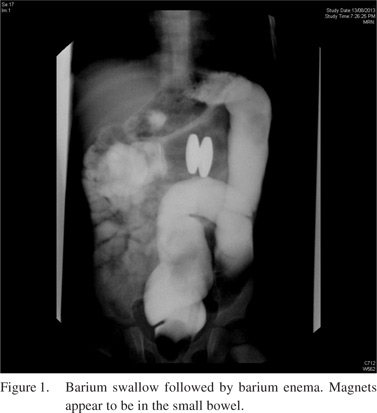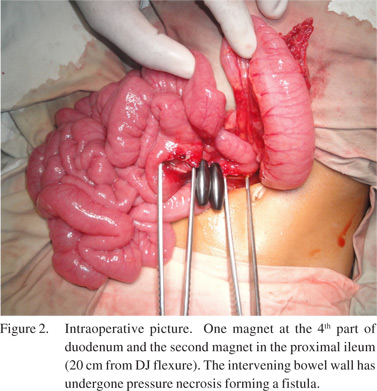48uep6bbphidvals|723
48uep6bbph|2000F98CTab_Articles|Fulltext
Toys containing detachable strong magnetic parts are a potential health hazard in children and the accidental ingestion of the same is being reported worldwide with increasing frequency.[1] Several algorithms designed to direct clinical decisions are available.[2-4] The spectrum of complications is possibly only unfolding. Increased awareness of the problems associated with magnet ingestion is necessary for parents, healthcare givers, toy makers and marketers.
Case history
A 2-year-old boy presented with history of ingestion of two magnets10 days previously. The child was immediately taken to a pediatrician who confirmed the presence of two magnets in the bowel by X-ray abdomen. The parents were advised to watch for spontaneous expulsion of the magnets. The child remained asymptomatic and hence the parents brought the child 10 days later because the magnets had not yet been expelled.
The child was evaluated and was found to be in good general conditions with no features of peritonitis or obstruction. An abdominal X- ray revealed two magnets stuck to each other in the left side of the abdomen at the second lumbar vertebral level. Barium swallow and enema confirmed the presence of the magnets in the small bowel (Figure 1).
The child underwent laparotomy and exploration of the magnets. Intraoperatively both magnets were found stuck to each other - one magnet was found in the 4th part of the duodenum and the other was in the jejunum, 20 cm from the DJ flexure (Figure 2). The bowel wall between the magnets had undergone pressure necrosis leading to a fistula between the two segments of bowel. The magnets were removed and the bowels repaired with absorbable sutures (4-0 Vicryl) after freshening the margins of the fistula. The child made a quick recovery and was discharged on normal diet a week later. The child was assessed and was found to be developmentally normal.


Discussion
Foreign body ingestion is a common clinical problem in the pediatric population. About 20% of the ingested foreign bodies require endoscopic removal as the majority are expelled in the feces on expectant management. Less than 1% present with complications requiring surgery.[3] Magnet ingestion has been a recent phenomenon with the earliest cases reported from Japan in 1991 where magnets were used for various musculoskeletal therapies[4]. In the recent past there has been an increased incidence of complications related to multiple magnet ingestion. This parallels the availability of strong
permanent magnets in childrens’ toys.[5] Magnet ingestion may be seen in normal children as well as those with autism and other behavioral disorders[1,6].
The history of magnet ingestion may be unavailable if the event is unwitnessed or unreliable if reported by a friend or sibling. The symptoms may vary from a completely symptomless child to one with features of obstruction, peritonitis or sepsis.[1]
Plain X-ray of the abdomen confirms the presence of a magnet or metallic object. Ultrasound abdomen and CT scans have also been used. However it may be impossible to determine with certainty if the magnet is single or multiple in some cases. MRI of the abdomen should never be used as it can precipitate a perforation[1].
Modern NIB (alloy of Neodymium, Iron and Boron[7]) toy magnets are 10 times more powerful than traditional magnets[8] capable of producing attractive forces up to 1300 G.[9] These have been known to erode through the intervening bowel wall resulting in perforation, internal enteric fistulae, internal herniation, adhesions, volvulus, obstruction[2], mesenteric hemorrhage[4] and death[3]. Enteric fistulae reported are jejunoileal, jejuno-caecal, jejuno-colic and ileo-ileal.[9-11]
Algorithms for the management of magnet ingestion recommend expectant management in the event of a single magnet ingestion. Prompt endoscopic or magnetic tipped catheter retrieval is recommended when multiple magnets or a magnet and other magnetic items are determined to be in the stomach. Surgical intervention is advised if the magnetic objects have progressed beyond the stomach.[2-4] Laparoscopic removal of the ingested magnets has been reported[12].
In view of the fallacy in relying upon the history or radiological imaging to determine whether the magnet ingested is single or multiple Butterworth et al have suggested treating suspected single magnet ingestions on similar lines of multiple magnet ingestion.[13]
The 2-year-old child in our case had been taken to a pediatrician immediately after ingesting the magnets. X-ray abdomen determined that there were indeed 2 magnets and the parents were advised conservative management awaiting spontaneous expulsion. This child’s condition underscores the general unawareness amongst all sections of society, including healthcare workers, of the dangers of ingesting magnets.
Following the death of an 18 month-old child due to multiple magnet ingestion, the government of Australia issued a permanent ban (effective 15 November 2012 onwards) on small powerful detachable magnets.13 Similarly, taking a cue from the much publicized Supreme court of India directive (2013-2014) on the restricted sale of household acid cleaning solutions, it may be of immense public interest to legislatively restrict the availability of small powerful magnets to children in India and other countries as well. Public and healthcare worker need to be educated about the perils of magnetic toys.
References
- George AT, Motiwale S. Magnets, children and the bowel: A dangerous attraction? World J Gastroenterol. 2012;18:5324–8.
- Verma S, Shinde S, Gupta CR. Multiple magnet ingestion: An uncommon cause of peritonitis. J Indian Assoc Pediatr Surg. 2013;18:160–1.
- Butterworth J, Feltis B. Toy magnet ingestion in children: revising the algorithm. J Pediatr Surg. 2007;42:e3–5.
- Vijaysadan V, Perez M, Kuo D. Revisiting Swallowed Troubles: Intestinal Complications Caused by Two Magnets—A Case Report, Review and Proposed Revision to the Algorithm for the Management of Foreign Body Ingestion. J Am Board Fam Med. 2006;19:511–6.
- Brown JC, Otjen JP, Drugas GT. Too attractive: the growing problem of magnet ingestions in children. Pediatr Emerg Care. 2013;29:1170–4.
- Oestreich AE. Worldwide survey of damage from swallowing multiple magnets. Pediatr Radiol. 2008;39:142–7.
- Fraden J. Handbook of Modern Sensors: Physics, Designs, and Applications. 4th ed. USA: Springer; 2010.p.73.
- Hussain SZ, Bousvaros A, Gilger M, Mamula P, Gupta S, Kramer R, et al. Management of Ingested Magnets in Children. J Pediatr Gastroenterol Nutr. 2012;55:239–42.
- Honzumi M, Shigemori C, Ito H, Mohri Y, Urata H, Yamamoto T. An intestinal fistula in a 3-year-old child caused by the ingestion of magnets: report of a case. Surg Today. 1995;25:552–3.
- Ahmed AM, Hassab MH, Al-Hussaini AA, Al-Tokhais TI.Magnetic toy ingestion leading to jejunocecal fistula in a child. Saudi Med J. 2010;31:442–4.
- Saeed A, Johal NS, Aslam A, Brain J, Fitzgerald RJ. Attraction Problems Following Magnet Ingestion. Ann R Coll Surg Engl. 2009;91:W10–2.
- Dutta S, Barzin A. MUltiple magnet ingestion as a source of severe gastrointestinal complications requiring surgical intervention. Arch Pediatr Adolesc Med. 2008;162:123–5.
- Treasury. Competition and Consumer Act 2010 - Consumer Protection Notice No. 5 of 2012 - Imposition of Permanent Ban on Small, High Powered Magnets [Internet]. [cited 2013 Dec 29]. Available from: http://www.comlaw.gov.au/Details/F2012L02171